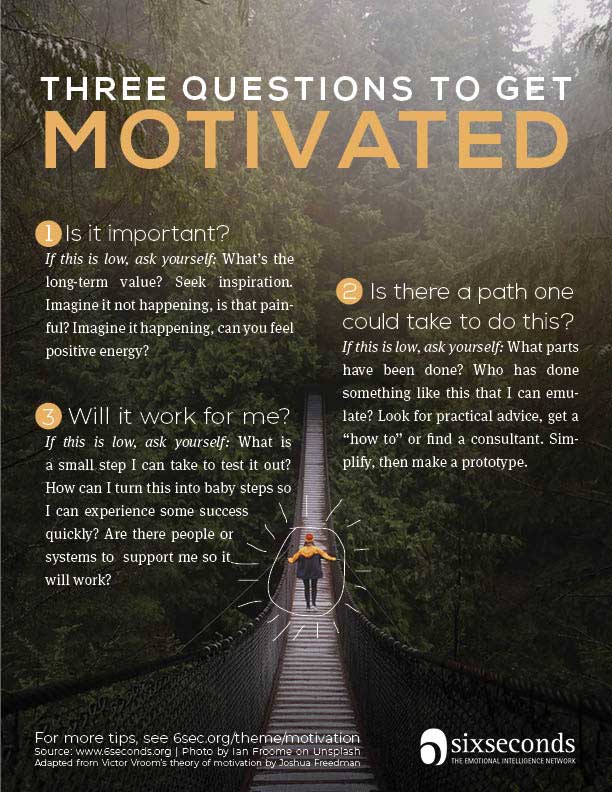Emotions As a Motivation Supercharger: 3 Essential Questions to Feel Motivated
How do we create the energy to step forward toward what’s truly important — especially when it feels difficult? How can we support others’ motivation?

At a neurobiological level, emotions are chemicals that carry information and energy to every living cell in our bodies. Various emotions are like ‘keys’ with a unique chemical structure, these keys attach to receptor sites (‘locks’) on our cells to deliver a message (and they last for up to about six seconds).
The information they carry is about opportunities and threats that we are perceiving. When we perceive a big opportunity or threat, we experience big feelings.
In other words, emotions are signals to focus us on what’s most important.
Emotion-chemicals also carry energy, and as Candace Pert explained, they change the electrical setpoint of all our cells. They’re part of our body’s regulatory system, and this energy (can) help galvanize us to address the opportunities and threats. At the same time, we’ve all experienced days when emotions feel like a barrier — for example when we’re overwhelmed by uncertainty or exhausted in burnout.
When our feelings are fueling momentum and taking us where we want to go, it’s fabulous! The question is: Can we access emotions as a source of energy and insight even when it’s hard. That takes a lot of emotional intelligence. Fortunately, we can grow emotional intelligence, and use it to harness our own emotions — and help others do the same.
With emotional intelligence, feelings energize us to nourish and protect our highest goals.
There are three “lenses” that I’ve found helpful in strengthening motivation, and how I use these as a coach:
- Intrinsic vs Extrinsic Motivation
- Practical vs Idealistic Motivation
- The Vital Signs of Motivation
Many of the articles I read about motivation offer fairly generic-but-good tips like, “break the task into small pieces,” or “write down your goal.” Great. But which of these practical tips apply to your specific situation?
Let’s suppose I’m your coach; you’ve told me about a goal you’ve set, but you’re not-quite-sure about it. I might ask you three questions:
How important is your goal?
How clear is the path to achieve this — is it doable?
To what degree do you believe that the path will work for you?
Going in the “way back machine” to Victor Vroom’s research on “expectancy theory,” these three questions reveal how likely it is that you’ll follow through on the goal.
What’s valuable in these questions is that they don’t just tell us about a level of motivation: They usually diagnose where the challenge sits. From there, we can design a solution. There’s a guide you can download from this page which offers example strategies for each of the areas. In each area, there is an aspect where emotional intelligence is the key.
Q1: For value, we need to FEEL the purpose.
Q2: For practicality, we need CONFIDENCE in the steps.
Q3: For self-belief, we need to TRUST ourselves.
Which is hardest for you? For me it’s usually the third that’s “the real kicker” (a kind of painful-but-freeing realization).
Once you see the challenge clearly, you can look at your situation through the three lenses of motivation to craft a solution:

What makes motivation? Here are three powerful questions + three lenses to understand the answers.
The third question is the kicker: Will it work for me?
Want more energy?
Get your poster with three essential motivation questions & tips for coaching yourself (and/or others)
The Three Lenses to Strengthen Motivation

Feel the Purpose
Is the motivation fueled from inside or driven by external factors?

Practical Plan
Do you see a path someone could take to reach the goal?

Believe You Can
Are all three “pulse points” active?
Depending on the area you want to strengthen, consider:
The Value of The Goal
Is it important to others? What are is essential for you? Engage Intrinsic Motivation is one of the competencies in the Six Seconds Model of Emotional Intelligence. While extrinsic forces do motivate us, they put the power in others’ hands. The word “engage” implies that the intrinsic motivators are present, we need to find a way to connect the current goal with the fire that’s burning within. Explore this competency.
A Plan That Makes Sense
As you think about a plan, it’s helpful to also consider how YOU work. One way is to learn about your Brain Style™. For example, in the Brain Brief Profile™, you can see if your brain energized by the practical or idealistic? While we all probably have both, you’re likely to lean one way or the other. If your brain is energized by the practical, then how can the current goal be translated to concrete steps? If you brain is energized by the idealistic, then how can you link the goal to long-term purpose? Discover the simple power of Brain Styles.
What YOU Can Do
It’s one thing to see a plan, another to believe it works for you. In a decade of research to create the EQ Performance Metrics, we identified three “pulse points” that drive motivation in an organizational context. They apply to personal life as well; you can use these to make sure your plan is something that feels viable.
Meaning. Your plan is linked to what truly matters to you.
Mastery. Rather than coming from behind, make sure your plan plays to your strengths.
Autonomy. While we need other people to thrive, make sure you make a plan that YOU can drive.
To increase motivation, make the goal meaningful, find aspects of it you’re great at, and create the freedom+responsibility of personal ownership.
I’d like to leave you with one of my favorite quotations about motivation, below, and a question:
How are you spending your energy?
- What Are Emotions? Understanding the Science and Meaning Behind How We Feel - October 25, 2025
- Resilience in Recessionary Times: Emotional Intelligence Strategies to Stay Grounded in Escalating Challenge - October 5, 2025
- The Emotional Recession: Trillions of Dollars, Trillions of Heavy Days - September 8, 2025
